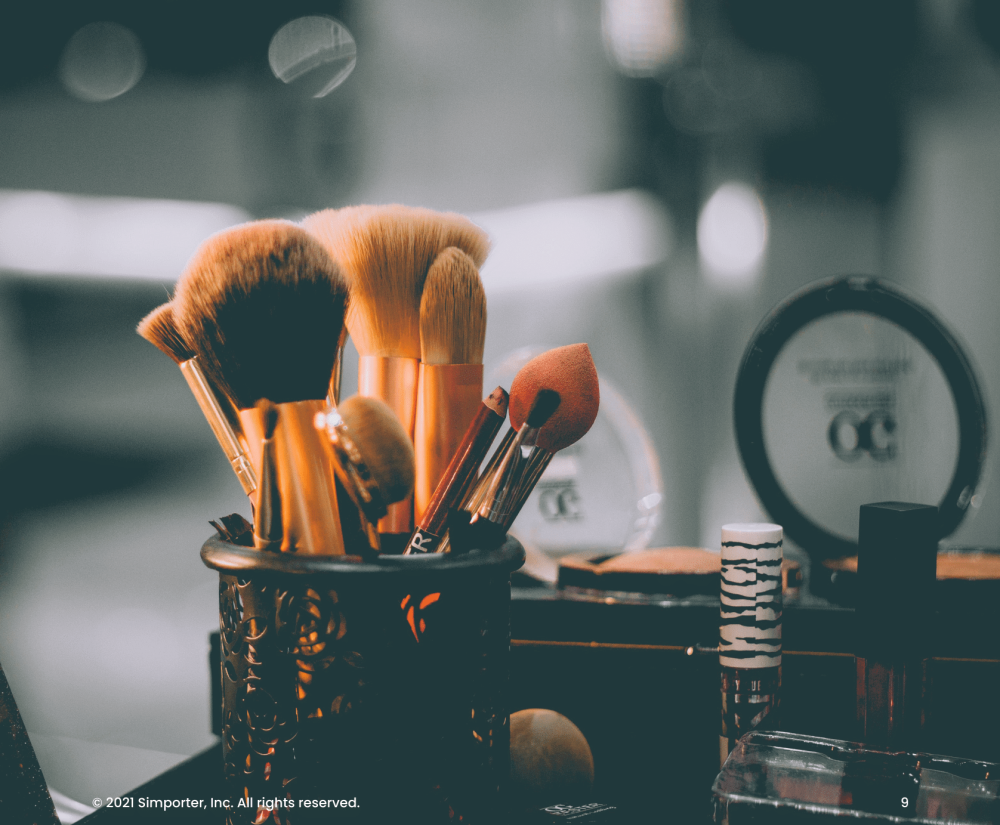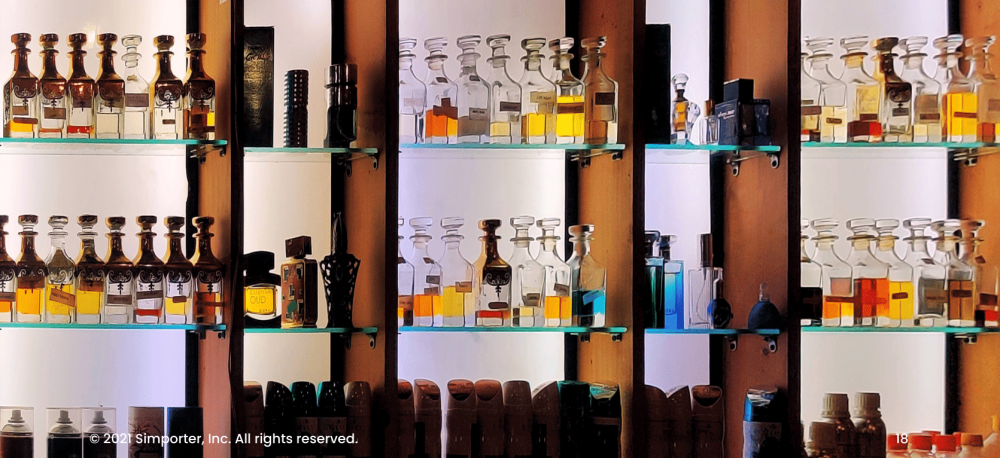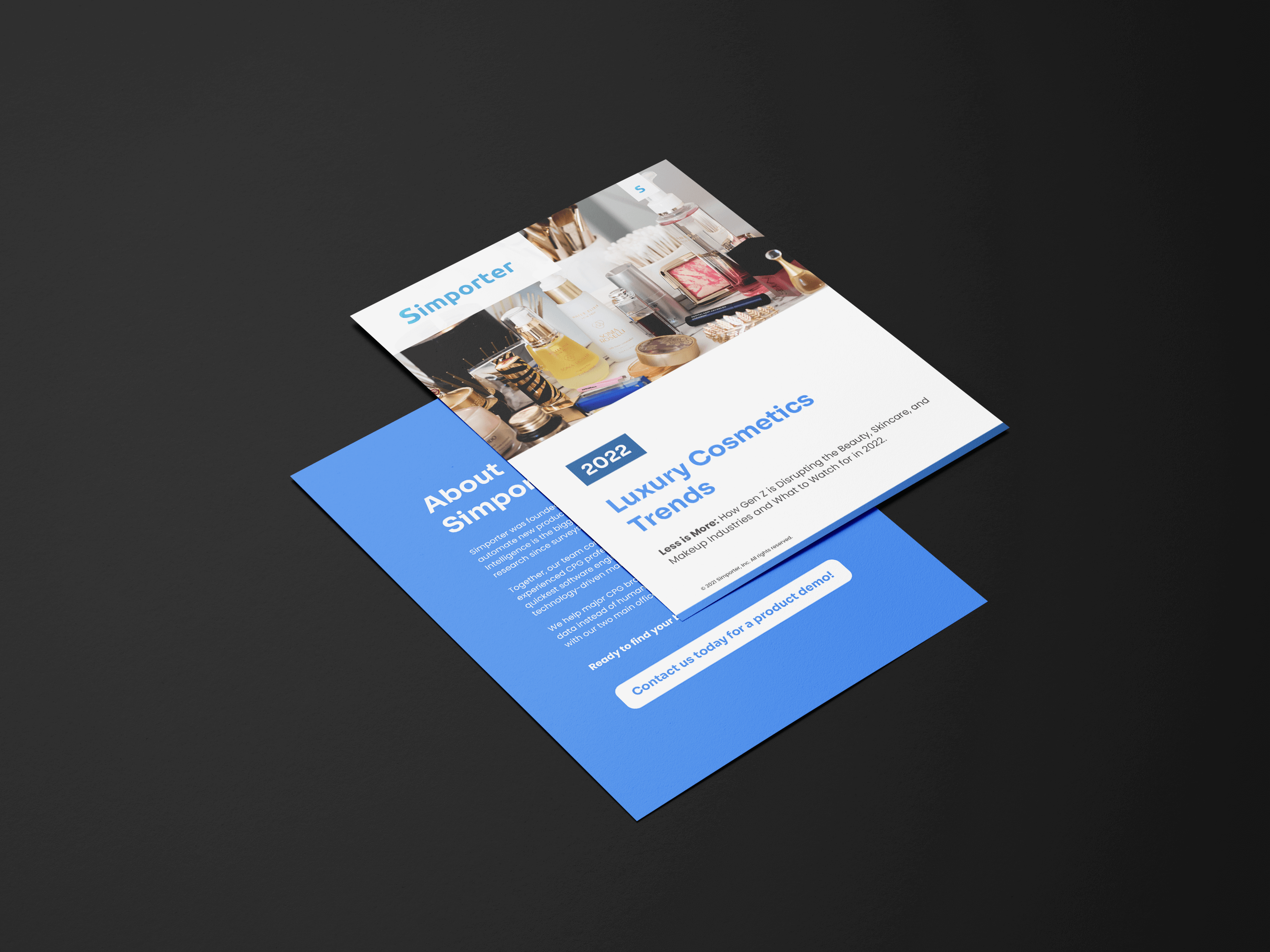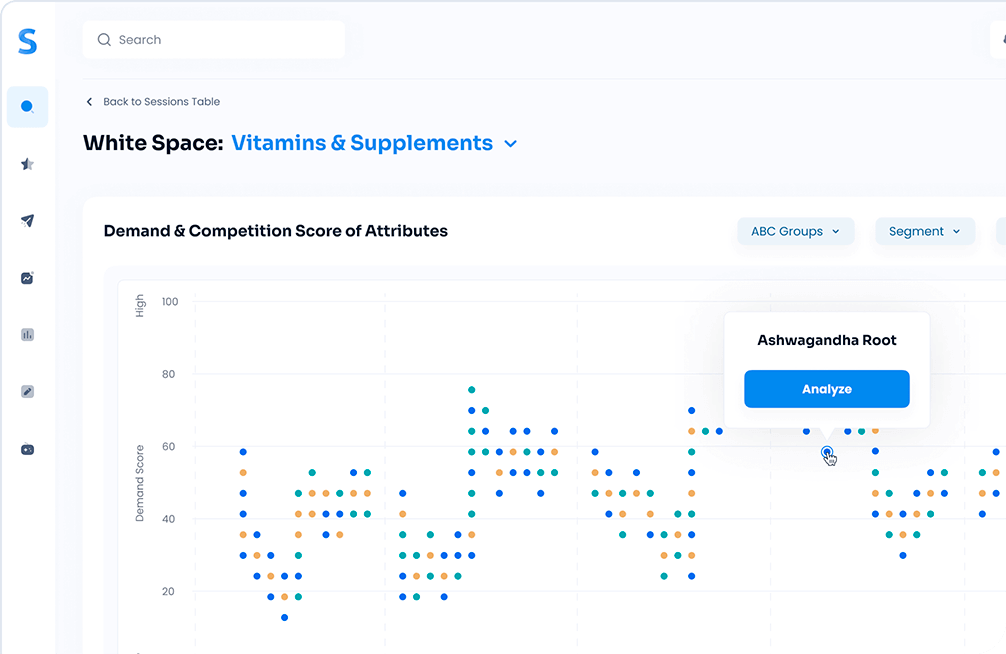Less is More: How Gen Z is Disrupting the Beauty, Skincare, and Makeup Industries and What to Watch.
Introduction
Long before Instagram influencers existed, young people have been the driving force creating and interpreting trends. The eldest of Gen Z, defined by those born between 1995 and 2023, are now in their early and mid-20s and year-over-year are seeing a dramatic increase in their spending power. These digital natives have been exposed to the internet and social media since a young age, making their generation comfortable collecting many sources of information before making a purchase decision. Quality cosmetics ingredients is the name of the game.
While millennials and older generations have been under the assumption that more is better, Gen Z fundamentally sees cosmetics in a different way. For them, less is more. Say goodbye to caked-on makeup because this generation is all about achieving effortlessly chic routines that are simple, clean, and sustainable.
Today’s consumers can no longer be swayed by high-end brand names and beautiful packaging alone. Younger shoppers have a sophisticated appreciation for ingredients and will be looking for clean products that truly connect with their audience’s needs. Sephora has a Clean Beauty Guide to help consumers find products without harmful ingredients and even breaks out products that are both clean and “planet positive.”
Additionally, with more time spent indoors during COVID-19, people wore less makeup and became more particular about what they put on their skin. Many opted for home spa days and DIY self-care regimens over the traditional commercial/retail spa experience and as a result, higher quality products were needed for home and personal use.
As the world returns to pre-pandemic norms, consumers will have less time and money to spend on their self-care regimen as they look to get more done with less – while not compromising on quality, sourcing, and sustainability.
Using our White Space AI tool, we’ve collected and dissected 3.8 million consumer data points to understand where consumer interest is headed in 2023 and beyond. Our software analyzes social media mentions, consumer sentiment patterns, product descriptions, and search traffic to make highly accurate trend predictions. Through this process, we’re able to understand what ingredients, need states, and sensory attributes are coming up in that data. We use that information to make predictions about the future, taking the following into consideration:
- Consumer demand
- Overall opportunity size
- Competition
- Innovation opportunities
Our opportunity analysis helps brands understand where to invest next. This de-risks new product development and ultimately grows new product revenue. Data insights like these have proven useful to any business looking to get ahead of the curve.
Overall Insights: Gen Z is Changing the Beauty Game
With nearly 4M consumer data points analyzed, the team here at Simporter is predicting quite a bit of growth in the luxury cosmetics category. The beauty industry, while highly influenced by the COVID-19 pandemic and widespread use of facemasks, will also be profoundly impacted by Gen Z.
2023 saw an influx of user-generated data, such as social media mentions and product reviews, largely driven by the generation who grew up with it. As the world shut down and screens dominated day-to-day life, consumers redefined how they felt about how they looked and what they put on their skin. So, they’re going to be looking for products that meet these new criteria.
The luxury cosmetics market is expected to see rapid growth in 2023. While next year will still be considered a recovery period from COVID-19, more consumers will be talking about and searching for makeup and skincare products. According to Bloomberg, Gen Z is already spending 125 percent compared to pre-COVID-19 levels in 2019. Our team predicts this will continue to rise in 2023.
Not surprisingly, we will see a higher percentage of consumer conversations and searches for skincare than makeup. Younger consumers have embraced a less is more mindset. They’re stripping back skincare and makeup routines in favor of a more minimalist approach. This mindset is all about pulling back, harnessing the power of multitasking and multipurpose products, and committing to a more sustainable (and usually cheaper) beauty regimen.
Category Winners: Skincare Will Dominate the Conversation
We analyzed data points across 22 categories to get a sense for where the market will be focused in 2023. Powders and sun care/self-tanning products take the first two spots, growing 48 percent and 32 percent respectively. They’re followed by industry giants, creams and foundations, which are predicted to continue their strong performance into next year. Most of the predicted winning categories are skincare-focused, which is in line with younger consumer preferences for simple products that address multiple needs.
As people take off their masks and readjust to normalcy, they’re ready to break out their lip products. Lips rank 6th on the list with an 11.58 percent growth rate and 9.58 percent share of voice. Lips spiked in popularity when masks came off mid-2021, so the category was expected to rank at the top of the list in 2022. However, consumers are opting for powders and sun care/self-tanning products instead, doubling down consumer interest in skincare over makeup.
Category Losers: Pandemic Mammoths Will Lose Momentum
A number of categories are expected to lose momentum going into next year. Most interesting on this list are scrubs and masks, two products that carried so many through the pandemic. These two categories have been dominant the past 2 years, peaking during the COVID-19 pandemic. As we look to 2022, this dynamic will shift and these two categories will continue on a downward trajectory.
It’s evident that consumers have moved beyond self-care and will be interested in categories that better align with their post-pandemic routines. We’re no longer confined to our homes in the same way that we were for the vast majority of 2020 and early 2021, so products that require lengthy time commitments and/or daily reapplications won’t trend up in the same way we’ve seen over the last 18 months.
Subcategory Winners: Getting More Done with Less Product
While at-home self-care is declining, there are a number of subcategories expected to grow across the next year. Contour products (contouring is a makeup technique that uses cosmetics to define, enhance, and sculpt the structure of the face or other body parts) hold a very high growth opportunity, predicted to grow at 79.44 percent year-over-year. With the emergence of TikTok, Instagram Reels, YouTube Shorts, and other quick-tutorial channels, influencer communities have jumped on the trend and will continue to do so as we approach 2022.
Night creams are second on the highest opportunities list. With a 0.49 percent share of voice, night creams are expected to grow 85.5 percent, the largest growth potential of all the subcategories. With many readjusting to pre-pandemic routines, consumers will have less time to spend on at-home self-care regimens. Night creams are the perfect solution as people will try to get more done with less time, effort, and money.
Masks are a thing of the past in many states here in the US, as well as countries all around the world. So it shouldn’t be a surprise that other cosmetics subcategories we analyzed – such as eyeshadows, tinted moisturizers, and lipsticks – have shown high growth potential for the upcoming year. As more and more individuals return to their routines and see friends, family, and colleagues without masks, products like these will resurge in popularity and demand.

Subcategory Losers: Trading in the At-Home Spa
So, where is the share of voice declining? The bulk of negative growth rate is going to be seen across products used for at-home self-care, such as Cleansers, Eye Creams, Makeup Removers, etc. Overall, consumer interest will be shifting back to pre-COVID-19 norms. Regardless of which generation a consumer falls under, it’s evident that the reopening of economies worldwide will put a significant speed bump in the way of product development and growth within the at-home care categories.
Ingredients Winners and Losers: The Shift to Natural, Clean, and Eco-Conscious
Fan-favorite Aloe Vera tops the list with a 412 percent predicted growth rate. It’s chock full of minerals and well-known for its ability to soothe and hydrate the skin, minimize the impact of sunburns, and it can even help reduce acne. People are familiar with the ingredient, know how it can help, and feel satisfied when they use it.
Chia Seed Extract sits right behind Aloe Vera. It contains healthy fats that have been shown to help strengthen and restore the skin’s moisture barrier, which is helpful to those with dry skin conditions. Additionally, it combats the serious danger of long-term UV damage, which is something everyone should be thinking about.
As consumers look for more transparency behind their favorite products, ingredients like Rose Water, Jasmine, and Cucumber will likely struggle to compete. While very popular across 2019 and early 2020, they will continue to lose steam as consumers focus on products that are natural, clean, and eco-conscious.
Today’s consumers are keenly aware of what ingredients are used in their cosmetic products to make sure they’re safe and when possible, eco-friendly. The increasing awareness of climate change will push consumers to seek out ethical and environmentally conscious products.
Not only should cosmetic products make people feel good, but they also need to do good in the process. It’s evident from our analysis that in order to grow your business in the cosmetics industry, your ingredients will need to have a focus on quality, sustainability, and ethical sourcing.
Need States Winners and Losers: Younger Consumers and Evergreen Skincare Needs
Consumer demand is a critical component for any trend analysis, so let’s dig into consumer need states (needs consumers claim to have). We analyzed 107 needs to understand which are dominating consumer conversations.
There will be an overwhelming shift towards skincare needs as 2022 approaches. With COVID-19, people took more time to evaluate what mattered most to them in beauty and skincare products. Gen Z is flooding the market with evergreen skincare needs, such as dry skin, acne treatment, and bacteria removal and they’re likely the generation (along with Millenials) that hold the greatest buying power in these categories.
A number of trending needs from the past two years will see negative growth in 2022. While Hypoallergenic and Skincare Routine needs are certainly not going away any time soon, they will just not be searched for as often. Products for Routine and Daily Use will decline as consumers spend less time investing in self-care and more time commuting to work, at social gatherings, traveling, and doing other activities.
It’s not surprising to see Anti-Aging on the negative growth list as the market shifts to younger consumers who are interested in other needs. As mentioned previously, Gen Z will hold a significant share of the buying power in 2022. Therefore, products geared towards older consumers who see greater perceived value in Anti-Aging benefits won’t make as large of an impact on consumers as they have in past years.
Theme Winners and Losers: Drawing the Line on Sustainability
Our AI tool analyzed 38 themes to find those with the biggest potential in the new year. Talc-free takes the number one spot with an impressive 752.17 percent growth potential.
Talcum Powder is a common ingredient in powder compacts, finishing powders, eye shadows, etc. because it creates a soft, silky texture, reduces inflammation, and combats UV damage. However, it’s been reported to contain asbestos, which has been linked to causing Cancer. It’s even called out on Ulta’s Made Without List to help consumers make more informed purchasing decisions. Consumers will not only be looking for products without this ingredient, but they will be looking for products that specifically claim to be Talc-free.
Instagram is near the top of this list as social media ingrains itself in the everyday life of consumers. The majority of skincare and cosmetic influencers promote and educate via Instagram, so the platform will continue to grow with their established audiences and loyal followers.
As consumer preferences shift toward clean and natural, Vegan products will gain a lot of traction. People will spend more time researching to have a better understanding of what exactly they’re purchasing and whether or not the product is sustainably sourced. In many cases, consumers will go a level deeper to ensure that the company itself follows ethical eco-friendly practices in manufacturing, sourcing, and distribution of the products. Clean and natural tells you one thing, but Vegan adds an additional layer of assurance that the product purchased meets your quality standards and expectations.
Themes expected to see negative growth include Recycled, Celebrity Endorsed, and Hypoallergenic. While Recycled may be a surprise, it’s important to note that while consumers are focused on sustainability, they’re primarily focused on what they’re putting on their skin even in a time where environmental consciousness is top-of-mind.
Consumers will not be as concerned with the supply chain, packaging, or recycle-focused aspects of the product. There’s a lack of transparency around Recycled materials, so consumers are less likely to trust what is actually recycled, versus what simply claims to be recycled. However, Ulta Beauty has vetted brands like OSEA and Eva NYC for Sustainable Packaging, meaning at least 50 percent of their packaging is made from recycled or bio-sourced materials (or be recyclable or refillable). If other big-box retailers (i.e. Nordstrom, Sephora, Bloomingdales) can vet the brands they offer in-store and online, Recycled is sure to stabilize and even make a return to the priorities list for this category.
Fragrances Winners and Losers: Less will be More
We analyzed 28 different fragrances to see what will be trending next year. Natural elements like Rain Water and Vanilla take the top two spots on the list with impressive triple-digit growth potential and a decent share of voice over 1 percent each.
Consumer preferences will shift toward lightly scented and unscented fragrances, indicating consumers are doubling down on their interest in natural and clean scents for their homes, cars, and offices. More mainstream fragrances like Citrus are expected to perform well, just not as well as they have in past years.
Our predicted losers list is composed of previously popular Sweet, Floral, and Fruity fragrances. These fragrances will decline while natural fragrances ride the upswing. Floral fragrances will still be popular and hold considerable market share, but brands should look to lighten the scent or focus on more natural floral elements. Again, less is more to today’s buyer pool.

Forms Winners and Losers: The Minimalist Beauty Routine
Since forms are typically influenced by the other categories, we won’t spend a ton of time dissecting our predictions here. It’s not surprising to see Powders take the number one slot with the shift towards cleaner, minimalist beauty routines. Gen Z loves a fresh, natural, glowy look, so they will be looking for product forms like powders, pads, creams, and pills to fill this need.
Products that were essential to home spa care, such as Wipes, Oils, Sprays, and Serums, are expected to see negative growth. While likely to remain popular, they just won’t be at the forefront of consumer conversations. This is because many of these products feature ingredients that don’t check some of the “must-have” boxes we’ve addressed throughout this article, such as natural ingredients, ethically sourced, and so forth.

Colors Winners and Losers: Adjusting to Pre-Pandemic Norms
While bright colors like Red spiked when masks came off, the colors expected to perform the best in 2022 are colors and finishes similar to pre-pandemic preferences. Prior to COVID-19, the most popular colors being used across most makeup/skincare categories fell under what we’d classify as “natural” tones. High-impact colors and shines such as Sheer, Glitter, and Satin that spiked in demand mid-2021 are expected to normalize to pre-pandemic levels as we head into 2022.
About Simporter
Founded in 2018, Simporter is a data analytics firm that automates new product research with AI software to automate new product research.
Brands and retailers use our software to pinpoint which products consumers truly want and how much they will purchase. Our proprietary technology analyzes billions of data points from point-of-sales, search traffic, social media sentiment, and customer reviews.
For more insights on luxury cosmetics trends, you can watch our recent webinar 2023 Luxury Cosmetics Trends here on YouTube. If you’re ready to see Simporter AI in action and learn what it can do for you, request a demo on our website.









